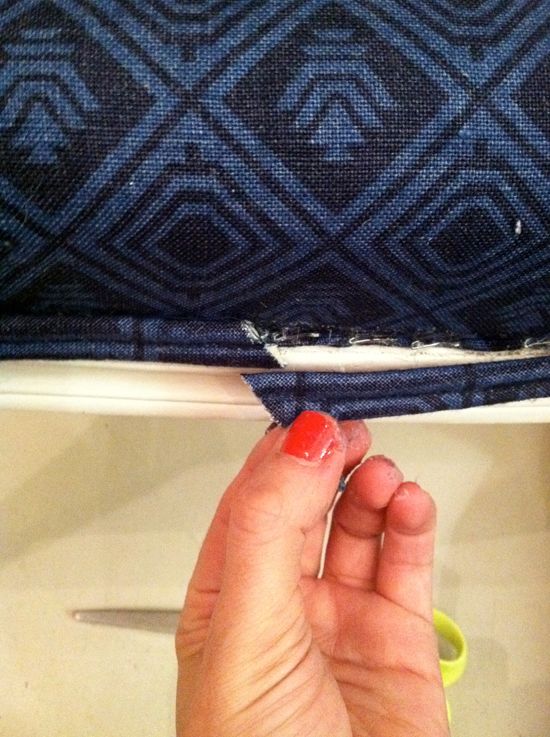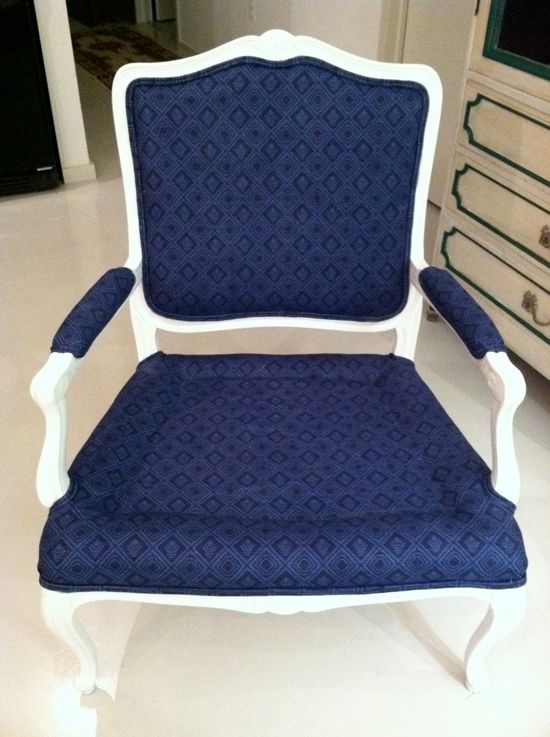There are lots of ways to trim out a chair. Probably the easiest thing to do is buy a ready made welting or gimp. If you get something at the store in a contrasting color it looks less lame/generic. But if you're up for it, I think a self welt is the best option. Double cord welting is awesome for DIY upholstery projects, because it covers a pretty wide area and makes sloppy stapling jobs look great.
Making your own double cord welting is actually pretty easy. Here are the simple steps:


You'll need lots of piping, so cut plenty of strips.


The basic idea is very easy. Lay the cording down on your long strip of fabric, fold over the strip and sew in a straight line about a 1/4" inset. You can use a zipper foot here, but my regular walking foot was fine here.

Once that cording has been sewn in, lay down a second piece of cording and roll the whole thing over:

Then simply stitch down the middle, between the two pieces of cord.

When you're finished sewing, trim off the extra fabric close to the seam and you're done!

I used only Magna-tac to attach my welting to the chair frame. Like I mentioned earlier, the glue dries very fast and the hold is very sturdy. I worked in about 10" lengths. I'd apply the glue directly to the cording, wait for just a few seconds for the drying process to get going, then then I pushed the cording down hard into the staples and gaps in the fabric.

While the glues dries very fast, it's a good idea to keep coming back to push in the welting into place while you're working on the rest of the chair. By the time you finish, everything will be securely glued and sitting where it's supposed to!

It helps to really get in the grooves if you sort of pinch the cording together, almost in half.

The bias cut welting really does well with corners. It's super easy to apply with all the stretch and give! If you don't have enough fabric to make bias-cut piping, you can definitely make piping with strips of fabric cut on a straight edge, there will just be more wrinkles and it will be tricky to get your corners completely covered.

There are a couple ways to stop your welting. Probably the cleanest looking method is to roll under the edges, but my piping was too thick, so I just cut the start and stop pieces on an angle. I cut the stop piece a little long. This helped for squishing the cording together and covering up the white parts. I also glued the inside/cut edge of the cording.

Not completely noticeable, right?

I love how upholstery projects absolutely come to life when the trim is added! Home stretch!

Last step is up next - sewing the cushion! Hint: if you can sew a pillow, you can make a cushion slip cover.

I love the fabric you used--it makes the chair look so regal!
ReplyDeleteJenny, what size of cording did you used?
ReplyDeleteWOW. You are making me think it's not that hard...I'm tempted.
ReplyDeleteIt looks great so far! I have to say that your upholstery tutorials have been the best ones I've seen! Maybe I'll get the nerve to try it myself now!
ReplyDeleteAmazing...you did all that?! Looks so great, and very inspiring!
ReplyDeleteThis really looks incredible! You're so talented and creative. Can't wait to see the cushion.
ReplyDeleteFashionable Collections
Your take on upholstering is spot on! You just have to take the leap and do it. Last summer I helped my niece redo her ugly overstuffed couch and loveseat with heavyweight gray POLAR FLEECE! It was amazingly easy to work with because and looks very "West Elm". Now the question I have about your welting project....how many glue gun burns did you get :)
ReplyDeleteLooks great! Thanks for the tutorial...I upholstered a similar chair using tacks and it took FOREVER, I wish I would've known about this! I can't wait to try it out!
ReplyDeleteYou make this look so do-able! Now I'm feeling brave....
ReplyDeleteholy wow. now my only reservation is 'wasting' fabric if I mess up! I have a wing back chair I got fre at a yardsale that'd yelling for attention so it can be useable in my house! :)
ReplyDeletethank you!
Loving this! Cording has always intimidated me! Your chair looks amazing and so well done. Looking forward to the cushion!
ReplyDeleteThank you so much for this awesome tutorial!! I can't wait to try it out.. now just need to find some chairs! :) Yours looks amazing, by the way. I love that fabric!
ReplyDeleteI really appreciate your upholstering HOw to's ! I'm getting started to tackle one soon.
ReplyDeleteCaterine
730design.blogspot.com
Love it!!! I just bought a double welting foot for my sewing machine - and used it right away! You chair is looking great :)
ReplyDeleteBeautiful job! I love the white wood with the contrast of the navy fabric:). A fantastic tutorial!
ReplyDeleteWow - this project is looking absolutely amazing. Thank you for the tutorial! You are an inspiration, Jenny!
ReplyDeleteone word: GORGEOUS!
ReplyDeleteIt looks amazing. I am still not 100% I can do it, but I am inspired!
ReplyDeleteThank you for your wonderful tutorial! I've reupholstered chairs in the past and have used decorative cording, not knowing how to sew double-cord welting - until now!
ReplyDeleteAwesome post!
Thank you so much for doing this! I'm just getting ready to start my first upholstery project and now I'm feeling much more hopeful :)
ReplyDeleteI am just so happy for this series of posts. You really do make it look easy. I got 2 upholstered chairs for free at a garage sale... so I will come back to these posts when I get the time to reupholster them. THANKS! They look fantastic too!
ReplyDeletePardon my french, but holy shit! Ive been working on my won chair redo and this was perfect timing! I could not wait to see how you finished this off since you stapled right over old fabric and on the front side of the chair. But it is BEAUTIFUL and I learned how to double welt in the process. Great job!
ReplyDeleteOh my goodness! I wish I had your patience to reupholster a chair. It looks beautiful by the way. Can't wait to see the finished result!
ReplyDelete~Kristy
www.idesignlove.com
Very excited about your tutorial. You're doing a fantastic job (and now I see all the mistakes I made on my sofa).
ReplyDeleteBut when do we get to hear about Sarah and Tommy?! :D
WOW!!! and to think I paid to have mine done. It really looks great. That is such a skill to have in your back pocket. Great job
ReplyDeleteThis is such an amazing DIY series. That trim looks incredible.
ReplyDeleteYou are making me think it's not that hard. Impressive!
ReplyDeleteSilver MLM
I started my chair tonight and will trim it tomorrow! I will send a picture when it is done. Thank you SO so much for the tutorial.
ReplyDeleteThanks for this lesson Jenny! It just solidifies the concept that having a well-designed home doesn't mean you have to have lots of money, just a creative mind and a "can do attitude." These chairs look so chic!
ReplyDeleteDoesn't it make you happy when a project REALLY turns out wonderfully! Great job...
ReplyDeleteEven though you make it look easy, I'm positive this is a project I could never do. You are so talented! I love your tutorials!
ReplyDeleteHi Jenny,
ReplyDeleteThanks very much for this tutorial. You are explaining each step so clearly, showing good pictures of the process and offering helpful tips. I appreciate all the work you've put into this and celebrate the beautiful results. BRAVA! BTW, it was exciting to see all your mentions in Better Homes & Gardens this month. Great publicity!
Love.
ReplyDeleteYou make it all look so easy!
xo,
cristin
I can't thank you enough for this series! I learned so much and I know I'll be referring to these posts again and again. I'll be spreading the word as well.
ReplyDeleteThey are sooooo beautiful!!! You did such a great job and you've inspired me to try it for myself!
ReplyDeleteAmazingly detailed tutorial and such beautiful results!! What is the fabric you are using??
ReplyDeleteYou are amazing. Truly amazing!!
ReplyDeleteLovely tutorial - I'm sending to my mom who has had a recovered chair minus the trim sitting about for quite some time...
ReplyDeleteOne more trick on the ends meeting...if you cut the just the cording on the inside and pull it out then you can have the empty shell of the cording, can tuck it under and match it up in the same way you did. Folding under and you don't have the chance of the cut sections unraveling...I can take some pictures if that would make it clearer...
Okay you are officially amazing. You did a fabulous job and it is looking sooooo easy, which I really don't believe. Ha!
ReplyDeletexoxo
Karena
Art by Karena
Come and join a very Fashionable Giveaway!
Love that fabric, who makes it?
ReplyDeleteAnd thank you for a wonderful tutorial. Almost everything I make is from a blog and I've learned so much and realized how much i can make!
Jenny, really great chair! I learned a great tip on ending welt when I took an upholstery class (Eliot School of Fine Arts in Jamaica Plains,its great!!!). Rip the seam just a few stitches at the end pull the fabric down to show some cording, and then cut a snip (1/4" or 1/2") of the cording off. Pull the fabric back up, fold under, and glue! You can do that at the beginning too, so then there is no exposed cording at all.
ReplyDeleteBTW, I first learned of your blog from a girl who was in my upholstery class. She always was saying "I don't know how that lady on Little Green Notebook does all these uphostery projects without having an instructor to teach her....Its amazing.
I am learning so much from this blog... Awesome. I can't wait to get going on some of this!
ReplyDeletesuch great projects...
Such a great tutorial! Can't wait to try this!
ReplyDeletenope too much work, I am just going to buy a new chair.
ReplyDeleteWow Jenny! I haven't had much times for blogs in the past few months. To think of all I've missed on yours. You are absolutely amazing! And you're tempting me to try this at home. To think of the money I'd save. I love that I can go back to your blog and search any DYI project, that I have the nerve for, and find such fabulous detailed instructions. Love the fabric you chose too. xoxo
ReplyDeleteyour instructions are so helpful, thank you! now i feel like i can maybe attempt this!
ReplyDeleteamazing only one word............
ReplyDeleteJust found your blog and getting ready to tackle my own first up project. Your chairs are so beautiful and I am starting to be slightly more excited than nervous about this new task! Just wanted to say thank you so much for this blog...so, so helpful!
ReplyDeleteAndrea